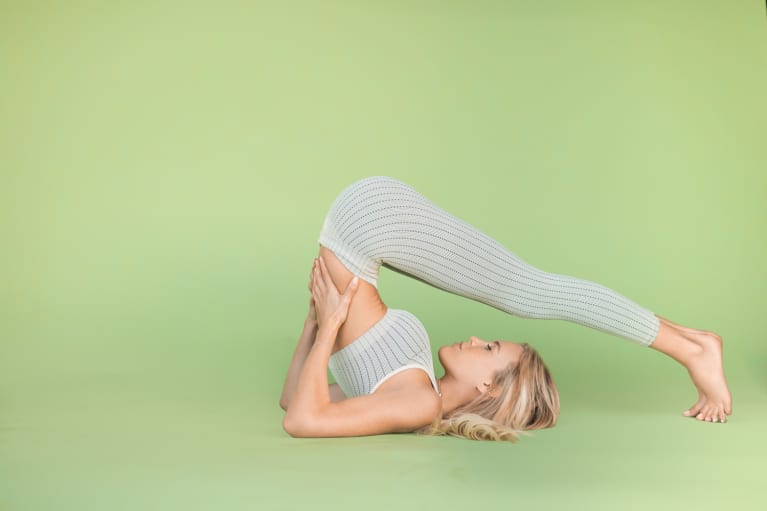Yoga Beginner’s Guide To Padangusthasana Yoga Pose
Although the history and origins of yoga go back 5000 years, it is still relevant in today’s stress-filled world. The health benefits have made it a global phenomenon, not to forget the numerous styles like Hatha, Vinyasa, Kundalini, and Bikram yoga among others. Among these, Ashtanga yoga has what is known as Padangusthasana yoga pose which is a bit demanding yoga asana but does offer some major health benefits.
Padangusthasana is a fundamental Ashtanga yoga asana that includes standing straight with a forward bending motion. This yoga asana gives your entire body a good stretch and relieves you of any pain and tension. One of the benefits of this Ashtanga yoga asana is it is excellent for flat feet. Come, let us understand in-depth about this wonderful yoga asana.
Padangusthasana Yoga Pose – A Brief Introduction
The word Padangusthasana comes from the Sanskrit language and comprises of three root words;
- The word Pada means foot
- Angustha means Big toe
- Asana refers to the yoga pose
In short, this yoga asana includes grabbing your big toe with your hands using a forward bend motion.
Do you know this Standing Yoga pose offers some major health benefits?
Padangusthasana Yoga Pose Benefits For Health
Given below are six major health benefits of Padangusthasana;
1. Stimulates The Endocrine System
The forward bend motion you do in this yoga asana activates the pineal gland, pituitary gland, thyroid gland, adrenal gland, and pancreas. All these glands are a part of the endocrine system which helps improve your overall body balance.
2. Activates The Abdominal Region
During Padangusthasana, the pressure you feel on the lower and upper abdomen while bending forward engages the abdominal muscles. Daily practice, improves the functioning of your abdominal organs, improves digestion, and the functioning of your liver and kidneys.
3. Tones Your Legs
The forward bending motion tightens your leg muscles at the hamstrings and calves. This improves blood circulation which helps create stronger muscles and a toned look.
4. Helps Prevent Osteoporosis
With time, your bones start losing calcium and minerals which makes them less dense and strong and eventually leads to osteoporosis. The Padangusthasana strengthens your entire body’s muscles and keeps you away from this degenerating health issue.
5. Best Yoga Pose For Athletes
Since this yoga pose works on your leg muscles, it offers professional athletes a great workout for their lower bodies. This yoga pose is an excellent post-event exercise as it relaxes the legs by providing them with a fresh flow of blood and improves circulation.
6. Cures Insomnia
With the forward bending motion in this Forward Bend Yoga Poses, your brain receives a dose of fresh blood which provides you calm. A rested and calm mind is what helps you sleep peacefully at night and keeps Insomnia away for good.
However, for you to reap all these benefits, you must know the correct technique for doing this yoga pose.
Guide To PadungusthasanaYoga Poses Steps
- Stand straight on the yoga mat with your inner feet parallel and 5 inches apart.
- Keep your arms and legs straight. Take long and deep breaths.
- Inhale. Bend forward from the hip joint and not the waist.
- Bring your head and torso down as one unit.
- After bending down, try to touch your forehead to your legs or knees. Make sure to take the torso near your legs.
- Hold the big and second toe with your index and middle finger. Hold with a strong grip.
- Curl your fingers down and press both toes down against your fingers.
- Inhale. Lift your head and torso.
- Straighten your hands and elbows.
- Hold this pose for 30 seconds.
Note: As a beginner, if you are unable to touch your toes, you can keep a yoga belt underneath the balls of your feet. Hold both ends of the belt to pull yourself down as far as you can comfortably.
However, you also have to keep a few things in mind to do the Padangusthasana without injuring yourself.
Safety Tips For Padungasthasana Yoga
Given below are some safety tips you should keep in mind when doing this Forward Bend Yoga Poses;
1. Lower Back Injury
Never practice the Padangusthasana if you suffer from a lower back injury. This pose stretches your spine and practising it with lower back pain will only worsen the condition.
2. Pregnancy
Do not practice this Big Toe Pose if you are pregnant as it will put your lower back and abdomen under unnecessary pressure.
3. Neck Injury
Never practice this yoga asana with a neck injury. It will only worsen the discomfort.
Conclusion
The Padangusthasana, also known as Big Toe Pose is an effective yoga asana that helps you get rid of pain and discomfort in the body. However, this is a bit challenging yoga asana so you should do this under the guidance of a certified yoga teacher.










